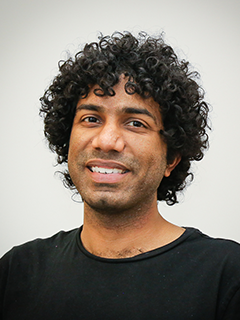News

INTERVIEW with 2021 G. COLONNETTI MEDALLIST, PRANNOY SURANENI
Dr Prannoy Suraneni is an Assistant Professor at the Department of Civil and Architectural Engineering of the University of Miami, USA. Dr Suraneni has been a RILEM member since 2018. He is the Deputy Chair of RILEM TC EBD “Test Methods to evaluate durability of blended cement pastes against deleterious ions”. Dr Suraneni is also an officer of the RILEM Educational Activities Committee (EAC). Dr Suraneni is an expert in the materials science, chemistry, and engineering of cementitious materials. His research strives to develop long-lasting concrete with low CO2 emissions through the use of novel waste materials. Dr Suraneni is one of the two 2021 Gustavo Colonnetti medallists. His presentation at the 75th RILEM Annual week was titled “Supplementary Cementitious Materials Reactivity: From Model Systems to Concrete”.
*******************************************************************************************************************************************************************************************************************************************************************
RIM: Congratulations for this award, Prannoy! I have the feeling I am interviewing a superstar: you graduated (B. Tech., Civil Engineering) at the IITM, India, in 2008; then you studied your M.S., Civil Engineering, at the University of Illinois, USA; that was followed by a Ph.D. in Civil Engineering at ETH Zurich, Switzerland, and a post-doc experience at the Oregon State University, USA. You are now an Assistant Professor at the University of Miami, USA… and you are only 34-year old!
P. Suraneni: I am not sure I am a superstar but the information is correct!
RIM: Being younger than 35 entitled you to apply for the Colonnetti Medal this year. Shall we start from there and your RILEM experiences so far?
P. Suraneni: Sure! I think the first major RILEM event that I attended was in 2016. That was the 70th RILEM Annual week celebrated in Lyngby, Denmark. I had attended other RILEM co-sponsored conferences before 2016, but that was the first RILEM Annual Week that I attended. I then attended the Annual Week the year after in Chennai, India, but I could not attend the next ones as that was a very chaotic period for me, as I changed positions in 2015 and then again in 2017. I started to get a lot more involved with RILEM from 2019 onwards. Now I am the Deputy-Chair of TC EBD “Test methods to evaluate durability of blended cement pastes against deleterious ions”…
RIM: Yes, the RILEM TC with the youngest chairing team as you and Dr W. Wilson, the TC Chair, are both under 40… under 37 to be exact!
P. Suraneni: Really? I didn’t know about that! One of the reasons for the establishment of this TC was a conversation between us, Karen Scrivener, Jason Weiss and a few more RILEM members regarding novel SCMs and durability. We identified the need to further investigate this topic and the TC was launched! I am very happy to be involved in this TC. It is very broad. I do not understand all the topics as an expert, and it is very nice to learn about several areas that do not belong to my expertise. We have some really fantastic members and it is very enjoyable to work with them.
I am also quite involved in other organisations similar to RILEM, like ACI and ASTM, and it is very enriching to see the differences between these institutions but also to apply the experience gained in one association to the practice in another association.
RIM: What happened with the Colonnetti medal? Was this the first time you applied? Has anyone strongly encouraged you to apply?
P. Suraneni: This was my second application. I also applied for the 2020 medal. Many people encouraged me to apply like Ravindra Gettu, Maria Juenger, and Jason Weiss. My philosophy is to always apply to medals and grants as you do not lose anything if you do not get it, but if you do, it is a life-changing experience. Furthermore, the application itself is a very good process especially when you get good feedback. I always encourage my PhD students to apply to apply for awards and scholarships for the same reasons. To be honest, I was not expecting to win this year but I am very happy I did!
RIM: Your presentation at the 75th RILEM Annual week was titled “Supplementary Cementitious Materials Reactivity: From Model Systems to Concrete”. Can you tell us more about SCMs?
P. Suraneni: SCMs are calcium aluminosilicate materials which are used to replace cement in concrete. Using these materials means reducing the carbon footprint of concrete production and improving concrete durability. The “problem” with SCMs is that the most commonly used SCMs, typically fly ash and slag, are running out and we have to find suitable replacements and characterise them. There are two broad aspects in my SCM research: 1) to understand the behaviour of these SCMs (characterization, reactivity, concrete durability), and 2) to allow their use in terms of approved specifications and standards. This latter is very applied research. But the truth is that we can carry out lots of fundamental research but, if it is not turned into standards/specifications, the impact of that research can be limited. There are lots of merits in doing “science for the sake of science”, but it is also important to have some practical impact, and given my experience with ASTM I can say that much research still misses that aspect.
RIM: What do you do to make sure that your research is not confined into a laboratory or it is not read only by PhD students? What is your strategy to reach a wider audience?
P. Suraneni: First I want to point out that “research for the sake of research” can be really awesome as, for instance, you can make discoveries that people will use 20 years later… and there is some research that I do that is “research for the sake of research”. To answer your question, one of the things I do is to work with industry, and keep them informed about what we do, but also by take on board their feedback. Another thing that we do on this matter is to develop “cheap” testing methods, so simple that you cannot really mess them up. The politically incorrect definition is “idiot-proof tests”. These activities are good examples of what could be joint efforts for RILEM, ACI, and ASTM. One case is the ASTM C618 and AASHTO M295 specifications for fly ash. Around a year ago, we wrote a paper that highlights the shortcomings of these specifications. Now we have come up with at least one test alternative for the strength activity test. We are now validating this method through round-robin tests. What we really need to make some of these changes is strong support from the industry. Then we will need to implement these changes within ASTM.
RIM: I think that RILEM is a great platform to get your network of laboratories to run round-robin tests and to validate the robustness of new tests. But what about the industry support?
P. Suraneni: I think that in RILEM there is less industry involvement than in other associations. However, I think this issue is currently being looked at and RILEM is trying to strengthen its industry relation. In our TC, we have Dr. Jose Pacheco from CTL Group and Dr. Chunyu Qiao from DRP, and they bring in very useful comments and feedback.
RIM: It is nice to see this industry involvement in a RILEM TC! Your activities within RILEM stretch from being Deputy-chair of a TC to being an officer in EAC. How is it going so far? Have you enjoyed being part of that Standing Committee?
P. Suraneni: Absolutely! EAC is great, and I am learning a lot. It is a good mix of senior and young members and I feel I am in the middle, in terms of experience, connecting to both. Providing guidance and direction to the young generation is critical. Take for instance the ROC&TOK recordings on YouTube. Each webinar has more than 500 views! So many PhD students are learning from those webinars. I love to be part of EAC and I also enjoyed participating in the RILEM strategy workshop.
RIM: I know you woke up very early to attend that workshop!
P. Suraneni: It was the first time for me to be involved in such a planning/strategy event and it was amazing!
RIM: I have two last questions for you: 1) where do you see yourself in RILEM in the future and 2) where do you see RILEM in the future?
P. Suraneni: I definitely want to keep contributing to RILEM as long as my years go. The amount of time that you can put into RILEM goes up and down, but ultimately being part of such an organization is very beneficial. You learn so much. I have to be honest: I feel the same about ASTM and ACI. These are the three organizations that are very close to my heart. Sometimes I spend more time here, other times there. But the nice thing is that I get very complimentary information from the three of them and can contribute to them in different ways. I see myself being involved in them for the rest of my career, life maybe is too much…
RIM: RILEM actually has a retired membership, so you can continue to be involved after the end of your career if you want!
P. Suraneni: Absolutely. But it is very funny that I only pay 25 euro/year because I am still considered a Young Member.
RIM: Yes, but from next year you will have to pay more 😊
P. Suraneni: I am actually happy to pay more and I really do not mind it. I also want to make sure that my students get involved in RILEM. It takes a little bit of time to get comfortable with any organisation, especially if you are a PhD student. I think that the RYC is the most beautiful initiative that I have seen. I met some of the Youth Council members and I feel they are absolutely fantastic. They are the future! Integrating them into TAC, DAC, and EAC will be very beneficial. I am not sure if I always see myself as a TC chair or Deputy Chair, but as long as I continue to be part of RILEM I can continue to learn. I am very curious to see how we will do with the hybrid technology, as in the last two years many TCs have met online before or after the RILEM Annual Week rather than in person during it. I am also curious to see how industry integration will be in the future. For me social media is another interesting point. I know that social media can be very bad for certain aspects, but it can be crucial in certain parts of the world to get people involved in RILEM. In terms of RILEM topics, I am keen to see RILEM work more on resilience and climate change. I think these are not conventional RILEM topics, and this explains why RILEM has not investigated them enough. But I think they have started to become very important and intimately linked to construction materials and structures…
RIM: … and interdisciplinary is another key factor. Don’t you think?
P. Suraneni: You literally took the words out of my mouth! Interdisciplinary is something that I am curious to see integrated into RILEM too. I do some interdisciplinary research as I work on bones and corals. You learn a lot by working in such environments and on such topics. It is also complicated as, you know… you are an expert in your own small topic. Interdisciplinary RILEM TCs might take a long time to be set up, longer than “conventional TCs”, but the pay-off is significantly greater. Another thing that is important to me is that engineers solve problems. Take the amazing job done by some scientists to analyse climate change… they have described the problem very well, but they do not always have solutions. Engineers can provide solutions, but they do not necessarily understand the details of the problem. This is a very simple example, and it might sound stupid if you write it down (Editor’s note: No, it doesn’t!).
RIM: Thank you again, Prannoy.
P. Suraneni: Thank YOU and let’s keep talking about RILEM!














No comment
Log in to post comment. Log in.